Places of Tourist Interest Around Kolkata
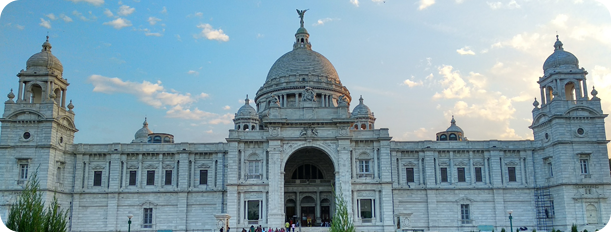
Victoria Memorial, Kolkata
The Victoria Memorial is a large marble building in Kolkata, West Bengal, India, which was built between 1906 and 1921.
Distance from downtown Kolkata: 2 km.
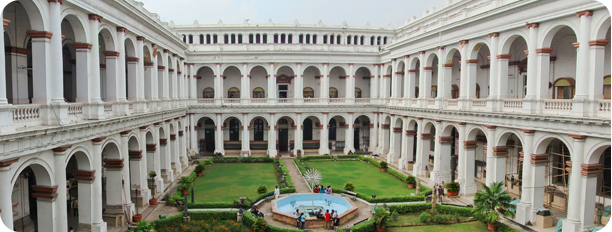
Indian Museum
Cultural museum established in 1814.
Distance from downtown Kolkata: 2 km.
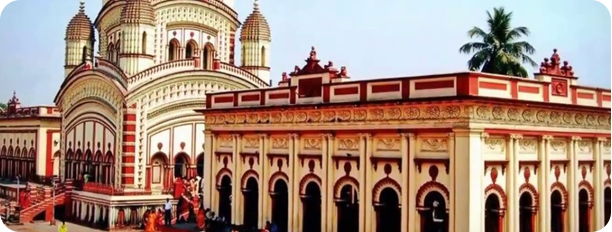
Dakshineswar Kali Temple
Striking 19th-century spiritual complex
Distance from downtown Kolkata: 14 km.
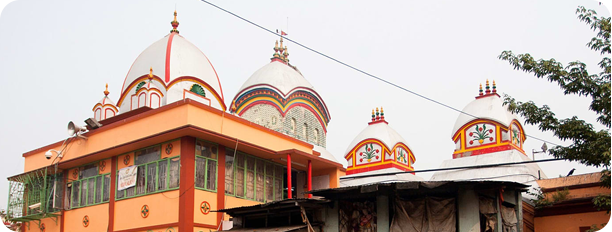
Kalighat Kali Temple
Mid 19th-century temple to Goddess Kali
Distance from downtown Kolkata: 5 km.
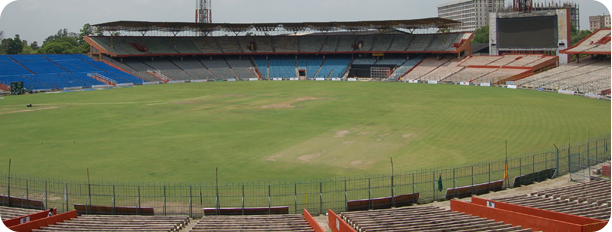
Eden Gardens
Large-scale, 19th-century cricket ground
Distance from downtown Kolkata: 3 km.
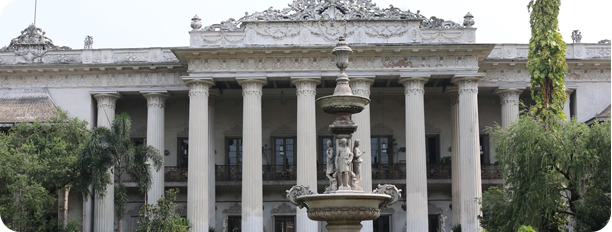
Marble Palace
Neoclassical building housing artwork
Distance from downtown Kolkata: 4 km.

Howrah Bridge
2,300-foot cantilever road bridge
Distance from downtown Kolkata: 6 km.
Museums and libraries
Gurusaday Museum, on Diamond Harbour Road, is the outcome of a lifetime of collection of traditional Bengal folk arts in undivided Bengal by Sir Gurusaday Dutt. On his death in 1941, the collection was handed over to the Bratachari Society founded by Sir Gurusaday Dutt to preserve and protect Bengal folk arts. It was opened as a museum to the public with the help of the Government of India in 1963. It contains, among other fine handicrafts, terracotta panels, kantha or folk quilt work, and patas ( or hand painted scrolls of the late 1900s), notably of the Kalighat School. The Asutosh Museum of Indian Art, on College Street, is the other museum specializing in Bengal folk arts, but with significant archaeological holdings from sites in West Bengal and Bihar like Chandraketugarh and Tamluk. The first university owned museum in India, it is run by the University of Calcutta and is named after its famous vice chancellor Sir Asutosh Mukherjee.
Nehru Children’s Museum is named after Jawaharlal Nehru, whose love for children was well known. The museum has a collection of dolls and toys from across the globe, and has a doll – based retelling of the Indian epics Ramayana and Mahabharata. Established in 1972 close to the Victoria Memorial, and commonly referred to as “Nehru Children’s Museum”, this museum is aging awkwardly fast. In order to pay homage to Pandit Jawahar Lal Nehru, National Cultural Association established the Museum in 1972 on Panditji’s name on his birthday. There are dolls which are not only bounded to India, but also of different states, countries, religious. Like- dolls of Bangladesh, Japan, China even of Rhodesia, Korea, Indonesia. Other than that there are dolls which are dressed according to the places like- Delhi, Assam, West Bengal, Chennai, Maharashtra, Andaman, Mexico, Portuguese and many more. there is even a separate cabin displaying various forms and styles of Ganash.
Sabarna Sangrahashala located at Baro Bari, Barisha, is the only family museum of Kolkata which is open to public. It was established in 2005 by the Sabarna Roy Choudhury Paribar Parishad and is a tourist destination specially for those who want to know more about the history of Kolkata. It is also a research institute in the making. The museum possesses some of the rarest Kabulatipatras, documents and articles of historical importance. The museum is dedicated to students for creating an awareness in history and culture.
National Library of India located in Alipore is India’s leading library and a public library. It was inaugurated in 1836 by the Governor General Lord Metcalfe by transferring 4675 books from the College of Fort William. Public donations were the main source of books for the library, and by donations of Rupees 300 from proprietors. Dwarakanath Tagore was the first proprietor of the library. The library was initially only partially public, as poor students could use the library for a limited period of time. The Imperial Library was founded in 1891 by merging several libraries like those of the East India College and East India Board. Governor General Lord Curzon initiated the merger of these two libraries into a single Imperial Library in 1903 at the Metcalfe Hall. The goals of the library were to collect every book written about India at any time. The Assistant Librarian of the British Museum John Macfarlane was the first librarian and was succeeded by the first Indian librarian Harinath De. The library was moved to its present quarters in Belvedere Estate, Alipore and renamed the National Library. It is a fully public library which co-ordinates the activities of all other Indian public libraries. True to its goal, any book published in India today has to send one copy to the National library in the spirit of the Library of Congress, United States.
Kolkata also has some other small museums like the Maritime Museum, and the Police Museum.
The other popular Kolkata libraries include the Ramakrishna Mission Library, maintained by the Ramakrishna Mission, Kolkata which has a special children’s section, as well as the large consulate-based libraries of British Council, Kolkata and of the United States Information Service, Kolkata. The Calcutta Club library has a historically significant collection, including the fully furnished and book-stocked reading room of Nirad C. Chaudhuri. The other historically significant libraries are those of Asiatic Society, Indian Museum, Presidency College, Scottish Church College, and St. Xavier’s College, Calcutta.
Heritage Administrative Offices
The General Post Office (GPO) in Kolkata
Calcutta High Court – It is the oldest High Court in India. It was established as the High Court of Judicature at Fort William on 1 July 1862 under the High Courts Act, 1861. It has jurisdiction over the state of West Bengal and the Union Territory of the Andaman and Nicobar Islands. The High Court building is an exact replica of the Stand Haus in Ypres, Belgium. It is recorded that when the original Stand Haus burnt down, a blue print of Granville’s Calcutta High Court had to be consulted before rebuilding it. The court has a sanctioned judge strength of 63. Despite the name of the city having officially changed from Calcutta to Kolkata in 2001, the old name is retained by the court as it is an institution.
Raj Bhavan (Government House) – It was built in the early 19th century, is modelled on Kedleston Hall. The house was once the seat of the viceroys of India; later, when the government moved to New Delhi, it became the residence of the Governor of Bengal, a function that it fulfills to this day. While the basic features of Kedleston have been faithfully copied (the Palladian Front, the Dome etc.), Government House is a much larger, three storeyed structure. Also, the Government of India evidently did not have the funding constraints that forced the Curzons to leave their house incomplete: Government House has all four wings originally conceived for Kedleston. So today, a ‘complete’, brick built Kedleston, on a much grander scale, is located in its acres of gardens at the heart of the Kolkata business district.
Town Hall – In Roman-Doric style, this building was built by the architect Col. John Garstin in 1813 with a fund of Rupees seven lakhs raised from lottery to provide the Europeans with a place for social gatherings. At first, the hall was placed under a committee, which allowed the public to use the hall under such terms and conditions as were fixed by the Government. The public could visit the ground floor hall to see statues and large size portrait paintings but they were not allowed indiscriminate access to the upper storey. Applications for the use of the upper storey were to be made to the committee. In 1867 Town Hall came under the custody of the Calcutta Municipality (later on Kolkata Municipal Corporation). In the year of 1897 the Town Hall had been partly renovated. After political independence in 1947, indiscriminate interference with the structure inevitably took its toll. That, at last, has been prevented in 1998 by timely intervention. The town hall was featured on the 6th leg of The Amazing Race 18, when the teams had to compete in a tea-drinking roadblock.
Writers’ Building – It is the secretariat building of the State Government of West Bengal in India.[2] The Writers’ Building originally served as the office for writers of the British East India Company, hence the name. Designed by Thomas Lyon in 1777 the Writers’ building has gone through several extensions over the years. In 1821 A 128 ft-long verandah with ionic style columns, each 32 ft high, were added on the first and second floors. From 1889 to 1906 two new blocks were added. It acquired its Greco-Roman look, complete with the portico in the central bay and the red surface of exposed brick. The parapet was put in place and the statues sculpted by William Fredric Woodington in 1883, that line the terrace, were installed.[3] The giant pediment at the centre is crowned with the statue of Minerva. The terrace also contains several other statues and notable among them are four clusters of statues, christened ‘Justice’, ‘Commerce’, ‘Science’ and ‘Agriculture’, with the Greek Gods and Goddesses of these four streams (Zeus, Hermes, Athena and Demeter respectively) flanked by a European and an Indian practitioner of these vocations, adorn the building.[4] The 150 meter long Writers’ Building covers the entire northern stretch of the a water body locally called Lal Dighi in B.B.D. Bagh area. Various departments of the West Bengal government are housed in this building. It is an edifice of great political significance and memories of the Indian Independence Movement. Writer’s building was used as Chief Minister’s Office and secretariat. However, from October 2013 certain departments and the office of Chief Minister moved to Nabanna, in Howrah to facilitate restoration of Writers Building.[5][6][7]
General Post Office – It is the central post office of the city of Kolkata, India and the chief post office of West Bengal. The post-office handles most of the city’s inbound and outbound mail and parcels. Situated in the B.B.D. Bagh area, the imposing structure of the GPO is one of the landmarks in the city.
Esplanade Mansions
South Eastern Railway Headquarters, Garden Reach
Howrah station – It is one of the four intercity train stations serving Howrah and Kolkata, India; the others are Sealdah Station, Shalimar Station and Kolkata railway station in Kolkata. Howrah is situated on the West bank of the Hooghly River, linked to Kolkata by the magnificent Howrah Bridge which is an icon of Kolkata. It is the oldest station and the largest railway complex in India.
Historic hotels
The Great Eastern Hotel (officially Lalit Great Eastern Hotel) was founded as the Auckland Hotel in 1841, at the crossroads of the Old Courthouse Street and British India Street, founded by confectioner David Wilson and named after the then Governor General Lord Auckland. It grew from strength to strength over the 19th and first half of the 20th century. Locally known as “Wilson’s Hotel”, it was also known as “Auckland Hotel and the “Hall of Nations” in the 19th century, and was referred to as the “Japani Hotel” (Japanese Hotel) colloquially in the 20th century, due to the large number of Japanese tourists there. The hotel was extremely elite, referred to as the “Jewel of the East” and “the best hotel East of the Suez” by Mark Twain on his voyage along the Equator, and described by Rudyard Kipling in “The City of Dreadful Night”. It had notable board members like the author Parry Chand Mitter and stockholders like W. C. Bonnerjee – president of the Indian National Congress. The hotel was famous for its new year parties thrown by Maharajahs (like the Maharajah of Cooch Behar) until the 1950s. It has been host to such notables as Elizabeth II on her India visit, Nikita Khrushchev’s delegation in the 1950s, and visiting international cricket teams. The hotel kitchens, manned by the legendary Baruahs of Chittagong (now in Bangladesh), was the talk of Kolkata. It steadily progressed downhill since the 1970s, and was taken over by the Government of West Bengal in 1975 on grounds of insolvency. Labour union problems caused the hotel to worsen until a sensationalist news campaign by The Telegraph exposed the sorry state of the hotel in the 1990s. The hotel was privatised in November 2005 with the help of PricewaterhouseCoopers and has been re-christened The LaLiT Great Eastern Kolkata. After an extensive restoration, a part of the property was reopened in November 2013. The Lalit Great Eastern offers 244 rooms and suites along with four restaurants and bars, the largest conference and banqueting facility in Kolkata, besides all other five-star deluxe facilities and services.
The Grand Hotel had humble beginnings. In the 1870s Mrs. Annie Monk opened her boarding house at numbers 13, 14 and 15 Chowringhee. In the meantime, Arathoon Stephen, Armenian from Isfahan had arrived in Calcutta and proceeded to make his fortune in the jewellery business. By the early 20th century he had put together a sizeable fortune and had purchased numbers 16 and 17 Chowringhee. Soon he purchased Mrs. Monk’s boarding house and number 18 Chowringhee as well, and proceeded to develop all the properties together into the hotel that came to be known as the Grand Hotel.
The Grand Hotel had humble beginnings as Mrs. Monte’s Boarding House at 13, Chowringhee Street. Acquired by the real-estate baron Arrathoon Stephen, it turned into a 3-story 500-room hotel. Acquired by hotelier Mohan Singh Oberoi in 1938, it became the Oberoi Grand. The hotel got a major lift during World War II when about 4000 soldiers were billeted there, and would party regularly. Events like the U.S. Marines’ Ball at the hotel remind visitors of such times.
Parks and gardens
Maidan means “field” in Hindi, Marathi and Bengali. The Kolkata Maidan was once a vast uninterrupted field, right down to the edge of the Hoogli, but is being encroached upon by the city and is fragmented by roads. The Maidan has nurtured sports like Polo, and has been the home of equestrianism, horse racing, football, cricket and rugby in Kolkata. It houses numerous clubs including the “big three” of Indian football – Mohun Bagan Athletic Club, East Bengal Football Club and Mohammedan Sporting Club along with their respective home stadiums. The arterial Chowringhee Avenue, Eden Gardens and the Millennium Park and the associated 3 km long Riverfront beautification project border the Maidan. The Maidan abounds with monuments and statues, the most famous of them being Shaheed Minar and the statue of ace footballer Gostho Pal. The Elliot Park, Mohor Kunja and the Victoria Memorial complex are three parks which are situated in the Maidan area.
Rabindra Sarobar or “The Lake” is an artificial lake and urban park in the spirit of Central Park, New York City. The park has a lake and an island with a footbridge, an open-air amphitheatre (Nazrul Mancha), a sports stadium (Rabindra Sarobar Stadium), a children’s park and the rowing clubs of Calcutta Rowing Club, Bengal Rowing Club and Lake Club.
The Salt Lake Central Park is a large urban park in the centre of the Bidhan Nagar township, with a lake in the middle and information technology and government offices along its fringes. New Town Eco Park (officially Prakriti Tirtha), located in New Town, is situated on a 480 acres (190 ha) plot and is surrounded by a 104 acres (42 ha) waterbody with an island in the middle.[8][9] The park has been divided into three broad parts; (1) ecological zones like wetlands, grasslands, and urban forest, (2)theme gardens and open spaces, (3)and urban recreational spaces.[9] The Eco Park is further divided into different sub-parts according to the different types of fauna planted.[10]
The Indian Botanical Garden, spread over 270 acres (1.1 km2), was founded in 1786 and is the oldest “botanics” in India. Housing 50,000 species, the Botanical Survey of India and one of the world’s most historically relevant herbariums, it is famous for its 250-year-old, 98-foot-tall banyan tree – which has the largest girth of any banyan tree ever recorded (1300 ft).
Alipore Zoological Gardens was founded in 1875, inaugurated by The Prince of Wales (later Edward VII). Initially started from the personal menagerie of the then Governor General of Bengal Arthur Wellesley and Carl Louis Schwendler – a German electrician, it grew based on gifts from British and Indian nobility – like Raja Suryakanta Acharya of Mymensingh in whose honour the open air tiger enclosure is named the “Mymensingh Enclosure”. The zoo was ill-reputed because of cross breeding experiments between lions and tigers to produce strains like tigons, ligers, and litigons. Adwaita was a male Aldabra giant tortoise in the zoo which died in March, 2006. He was reported to have been more than 250 years old – a candidate for the longest lived animal. The other success story of the zoo was a live birth of the rare Sumatran rhinoceros in 1889. The zoo is downsizing to meet animal comfort requirements laid down by the Central Zoo Authority of India. The zoo is also on the flyway for several migratory birds like the sarus crane.
A host of new amusement parks have sprung up in recent times – the most notable being Nicco Park – the first modern amusement park in Kolkata and Aquatica – the theme water park, both in Bidhan Nagar. Other important parks includes Nalban and Captain Bhery Eco & Aquatic Hub.
Places of Worship
- Dakshineswar Kali Temple
- Kalighat Kali Temple
- Birla temple
- Belur Math
- Firinghi Kalibari
- Thanthania Kalibari
- Dwadash Shiva Temples
- Badridas Jain Temple
- Belgachia Jain Temple
- Chitteshwari Temple
- Madanmohan Temple
- Mosques[edit]
- Main article: Mosques in Kolkata
- Tipu Sultan Mosque
- Nakhoda Masjid
- Niyamatullah Ghat Masjid
- Karbala Dargah
- Metiabruz Imambara
- Churches[edit]
- St. Paul’s Cathedral
- St. John’s Church
- Greek Orthodox Church
- St. James’ Church, Kolkata (Jora Girja)
- Church of the Lord Jesus
- Armenian Church of the Holy Nazareth
- Cathedral of the Most Holy Rosary (Portuguese Church)
- Other religious establishments[edit]
- Parsi Fire Temples
- Japanese Buddhist Temple
- Chinese temples in Kolkata
- Bhowanipore Gurudwara
- Magen David Synagogue
- Bethel Synagogue
- Gurudwara Bara Sikh Sangat


